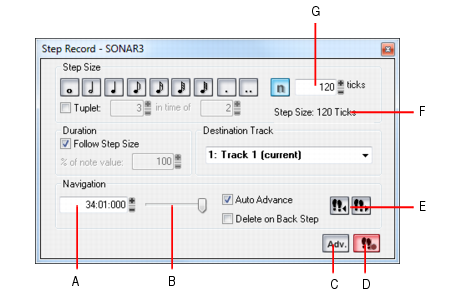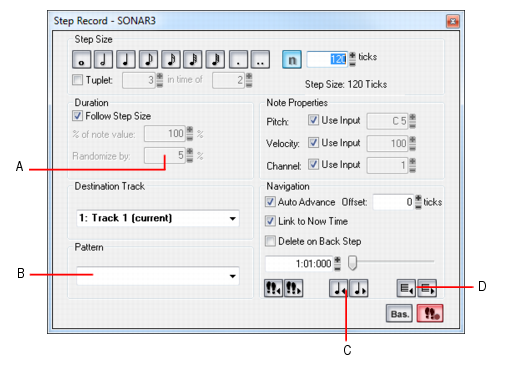Step recording is a method of recording MIDI notes one note or chord at a time. It’s a very easy and precise way to record, but can sound mechanical if used in the wrong situation. You use step recording in its typical form by choosing a step size, such as a quarter note, and then playing a note on your MIDI keyboard. When you play the note, SONAR records the note, and moves the insertion point forward by the distance of the step size (moving the insertion point every time you press a note is the default behavior). You can then record more notes of the same duration by playing notes on your keyboard, or you can change the step size while you’re recording and record different size notes. You can also choose how long the notes you play will sound, as a percentage of the step size. For example, even though you record some notes that have a step size of a quarter note, if you set the Duration field to
50%, the notes will be recorded and displayed as a series of eighth notes, each followed by an eighth rest. The insertion point for each recorded note in this example moves by a quarter note (the step size) each time you record a note. If the duration is longer than the step size, the notes will overlap with the notes recorded at the next step.
MIDI data is recorded using step record even if the track is not armed. Loop markers are ignored. And step recording always uses the Sound on Sound (blend) record mode, regardless of the current record mode.
With Auto Advance disabled, you must click
Advance each time you want to advance to the next step. While this requires more effort, it also provides you with more flexibility. For example, with
Auto Advance disabled, you do not even need to play the notes at a single step at the same time! You can play any number of notes one at a time, and they will all be recorded at the same step until you click the
Advance button. You can even record notes of different durations at the same step—simply record the notes of one duration, change the duration, and play more notes, without clicking
Advance.
The Step Record dialog box has two modes: Basic (smaller with fewer options), and Advanced (larger, more options). To use Basic mode, click the
Bas./Adv. button so that the
Adv. button is displayed. To use Advanced mode, click the
Bas./Adv. button so that the
Bas. button is displayed.
A. Randomize durations field
B. Step pattern recording field
C. Click to move insertion point by single beat
D. Click to move insertion point by single measure
|
|
|
|
|
Disable the Follow Step Size check box, enter a number into the % of Note Value field (leave it at 100 if you want to follow step size), and enter the maximum duration that the step size should be randomized in the Randomize By field.
|
|
|
To choose a constant value for pitch, velocity, or channel, disable the Use Input check box next to the desired field, and fill in the value you want to use for that particular parameter.
|
|
|
|
|
|
Enable the Link to Now Time check box.
|
|
|
|
|
|
Click the Beat Backward button  or the Beat Advance  button.
|
|
|
Click the Measure Backward button  or the Measure Advance  button.
|
|
|
|
The new note appears in your track, and the Now Time moves the distance of the two combined steps that you entered. To toggle the plus sign on or off in the Step Size “n” Ticks field, press the + key on the Num Pad. To clear a large value from the
Step Size “n” Ticks field, click a smaller value, or use a keyboard shortcut for a smaller value.
By default, opening the Step Record window will automatically enable step recording. SHIFT+R is the default shortcut to open the Step Record dialog box. Once the
Step Record window is open, you can enable/disable step recording at will without closing the Step Record window: just click the
Activate Step Recording button

in the
Step Record dialog box, or press SHIFT+R.
and keep the button pressed for a brief moment until the pop-up menu appears, then choose Step Record. The Record button changes to
.
to open the Step Record dialog box.

to move the insertion point forward by the current step size, or click the Step Backwards button
to move the insertion point backward by the current step size. SONAR displays the insertion point location in the Insertion point location field (see Basic mode picture above).


, enable the Tuplet check box, and fill in 3 in the time of 2, which means 3 quarter notes in the time of 2 quarter notes. If you want eighth-note triplets, click the eighth-note icon
, enable the Tuplet check box, and fill in 3 in the time of 2. If you wanted 5 notes in one beat, click the quarter-note icon, enable the Tuplet check box, and fill in 5 in the time of 1.

, and fill in the number of ticks in the Ticks field.



in the Step Record dialog box so that the button is not red. This disables step recording, allowing you to use both the mouse, and any keyboard shortcuts that the Step Record dialog box uses, for other commands.
By default, opening the Step Record window will automatically enable step recording. SHIFT+R is the default shortcut to open the Step Record dialog box. Once the Step Record window is open, you can enable/disable step recording at will without closing the Step Record window: just click the Activate Step Recording buttonin the Step Record dialog box, or press SHIFT+R.





